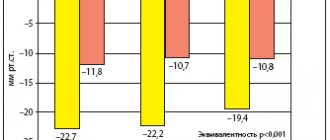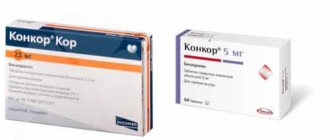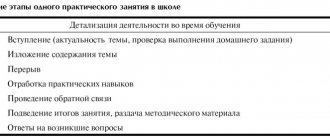Characteristics of Lisinopril
Lisinopril is an antihypertensive drug based on the active substance of the same name. Manufactured by Vertex. The composition includes auxiliary components that are taken into account by doctors when selecting the dosage of the drug for allergy sufferers or patients. Due to the active component, the following pharmacodynamic properties are formed:
- decrease in angiotensin, aldosterone, bradykinin, increase in prostaglandins, due to which blood pressure decreases;
- reducing the load on blood vessels;
- dilatation of arteries, to a lesser extent veins;
- reduction of the myocardium of a hypertrophied heart;
- increasing life expectancy by eliminating the negative effect on the cardiovascular system.
The drug is absorbed in the intestines, bioavailability is low. A small amount of the substance penetrates the blood-brain barrier. Metabolism practically does not occur. Excretion is carried out by the kidneys. The medicine is indicated for use in the following diseases:
- arterial hypertension;
- heart failure, history of myocardial infarction;
- diabetic nephropathy.
The product is not used in cases of hypersensitivity or systemic allergic reactions. It is not recommended for use during pregnancy or lactation in women, as the substance penetrates the placenta. There have not been enough clinical trials on minors, so the drug is not prescribed for them.
Mucaltin is a natural secretolytic that is prescribed to patients for the treatment of wet and dry cough in inflammatory pathologies of the lower respiratory tract. Read more in the article: “how to take mucaltin for adults.”
Side effects
The drug affects many organs and systems. More often, negative reactions develop due to irrational use or self-medication. The following side effects are possible:
- excessive hypotension, cardiac arrhythmia, myocardial infarction;
- numbness of the limbs, confusion, fatigue;
- decrease in the number of blood cells;
- cough, bronchospasm;
- dyspeptic reactions, changes in taste, inflammation of the pancreas and liver, jaundice;
- local, systemic allergy;
- inflammation of joints, muscles, blood vessels.
There are categories of patients for whom the drug can be used, but with caution. These include patients with a hypertrophied heart, hyperaldosteronism, chronic heart failure, diabetes mellitus, and autoimmune diseases. During therapy, it is recommended to take repeated laboratory tests of blood and urine. If you feel worse, the medicine should be discontinued immediately.
When choosing an anesthetic, each patient should be careful, as they have many side effects and contraindications. Tramadol is one of the effective drugs, but in case of individual intolerance, it is better to replace it with analogues that are not inferior in their effect on the body. Read more in the article: “how to replace tramadol for severe pain.”
Contraindications for use
- Hypersensitivity to candesartan or other components of the drug;
- lactose intolerance, lactase deficiency, glucose-galactose malabsorption syndrome;
- pregnancy;
- breastfeeding period;
- children and adolescents under 18 years of age (efficacy and safety have not been established);
- severe liver dysfunction and/or cholestasis;
- simultaneous use with aliskiren and aliskiren-containing drugs in patients with diabetes mellitus or impaired renal function (GFR less than 60 ml/min).
With caution: severe renal dysfunction (creatinine clearance less than 30 ml/min), hemodialysis, bilateral renal artery stenosis or stenosis of the artery of a single kidney, hemodynamically significant stenosis of the aortic and/or mitral valve, hypertrophic obstructive cardiomyopathy (HOCM), condition after kidney transplantation, cerebrovascular disorders of ischemic origin and ischemic heart disease, hyperkalemia in patients with reduced blood volume, general anesthesia and surgical interventions (risk of developing arterial hypotension due to blockade of the RAAS), primary hyperaldosteronism.
Characteristics of Lozap
Lozap is an antihypertensive drug based on losartan potassium. Available in coated tablets consisting of excipients. Due to the active component, the following pharmacological actions are formed:
- relaxation, elimination of vascular spasm;
- decrease in angiotensin, aldrosterone;
- no effect on ACE.
Absorption occurs through the intestines. Bioavailability is low. There is no penetration through the blood-brain barrier. Metabolism occurs in the circulatory system. Excretion occurs through the kidneys. Indications for use:
Advertising:
- arterial hypertension:
- heart failure;
- diabetic nephropathy.
The medicine is contraindicated in case of individual intolerance, severe liver damage, and minors. It should not be drunk during pregnancy or lactation; the active substance penetrates the placental barrier. It is not recommended to combine ACE inhibitors and Lozap.
Side effects
Despite its high effectiveness, the product has many side effects. Allergic reactions develop more often at the local and systemic level. But there are other negative consequences:
- reduction of blood sprouts;
- headache, migraine, depression;
- tinnitus, increased heart rate, arrhythmia, excessive hypotension;
- cough, shortness of breath;
- dyspeptic reactions, nausea, inflammation of the pancreas and liver;
- inflammation of muscles, joints;
- kidney inflammation, kidney failure;
- impotence;
- weakness, swelling, malaise
There are diseases and conditions for which the drug is compatible, but is used with caution. These include heart failure, arrhythmia, low-grade cardiomyopathy, liver or kidney failure. The product can also be used after 75 years. For all these conditions, it is recommended to periodically undergo examinations, take laboratory tests of blood and urine.
Use during pregnancy and children
The drug Giposart is contraindicated for use during pregnancy, because it has a direct effect on the RAAS and can cause developmental disorders of the fetus (especially in the second and third trimesters of pregnancy) or have a negative effect on the newborn, including death, if the drug was used during pregnancy.
It is known that therapy with angiotensin II receptor antagonists (ARA II) can cause fetal developmental disorders (impaired renal function, oligohydramnios, delayed ossification of the skull bones) and the development of complications in the newborn (renal failure, arterial hypotension, hyperkalemia). If the fact of pregnancy is established, the drug Giposart must be discontinued as quickly as possible.
When planning pregnancy, it is necessary to transfer the patient to adequate alternative therapy.
It is not known whether candesartan is excreted in breast milk, but it is known to be excreted in the milk of lactating rats.
During treatment with Hyposart, breastfeeding should be stopped. Newborns whose mothers took Hyposart during pregnancy should be under close medical supervision due to the likelihood of developing arterial hypotension.
Use in children
The use of the drug is contraindicated in children and adolescents under 18 years of age (efficacy and safety have not been established).
Comparative characteristics of Lisinopril and Lozap
Both drugs have antihypertensive effects. They are effective and low cost. The following similarities are highlighted:
- in addition to the main indication in the form of arterial hypertension, they are prescribed for increased blood pressure due to complications of diabetes mellitus, heart failure;
- a large number of side effects that must be taken into account when prescribing and using the drug;
- use of substances for serious diseases of internal organs, in old age, but under the supervision of a doctor;
- possibility of overdose.
Since the active ingredients are different, the drugs differ from each other. Because of this difference, a doctor may prescribe one drug and refuse another. The following differences are distinguished:
- Lisinopril inhibits ACE, Lozap does not;
- substances differ in pharmacokinetics, Lozap has metabolites;
- Lisinopril can additionally be used for myocardial infarction;
- Lozap does not have the ability to block angiotensin receptors, so the decrease in blood pressure does not occur directly, but indirectly.
Both substances are useful for arterial hypertension. Lisinopril is most often recommended; it affects ACE. If the patient has contraindications to it, Lozap is prescribed. It is less likely to cause negative actions.
Dosage
The drug is taken orally, 1 time/day, regardless of the time of meal.
Arterial hypertension
The recommended initial and maintenance dose of Giposart is 8 mg 1 time / day. If necessary, the dose can be increased to 16 mg 1 time / day. The maximum antihypertensive effect is achieved within 4 weeks of therapy. The maximum daily dose is 32 mg 1 time/day.
If adequate blood pressure control is not achieved at the maximum daily dose, it is recommended to add a thiazide diuretic (eg, hydrochlorothiazide) to therapy. This may enhance the antihypertensive effect of Giposart.
In patients at risk of developing arterial hypotension (including patients with reduced blood volume), it is recommended to start therapy with a dose of 4 mg.
In patients with mild to moderate renal impairment (creatinine clearance 30-80 ml/min/1.73 m2), including patients on hemodialysis, the initial dose of the drug is 4 mg. The dose should be titrated depending on the therapeutic effect. Clinical experience with the use of the drug in patients with severe renal impairment or end-stage renal failure (creatinine clearance less than 15 ml/min) is limited.
The initial daily dose of the drug in patients with mild to moderate liver disease is 4 mg. It is possible to increase the dose if necessary. There is no clinical experience with the use of the drug in patients with severe liver dysfunction and/or cholestasis.
Chronic heart failure
The recommended initial dose of Giposart is 4 mg 1 time / day. An increase to a maximum daily dose of 32 mg 1 time / day or to the maximum tolerated dose is carried out by doubling the dose with an interval of at least 2 weeks.
Elderly patients and patients with impaired renal or liver function do not require adjustment of the initial dose of the drug.
The safety and effectiveness of the drug Giposart in children and adolescents under 18 years of age have not been established.
Concomitant therapy
The drug Giposart can be used simultaneously with other drugs for the treatment of CHF, including ACE inhibitors, beta-blockers, diuretics, cardiac glycosides or combinations of these drugs.
Selection of analogues
Advertising:
If the patient is not satisfied with the price, it is recommended to select an analogue with the same active ingredient, but at a lower cost. If there are contraindications, look for a product with another active ingredient that will not cause negative effects. The data is shown in the table.
| A drug | Active substance | Leader | Price |
| Diroton | Lisinopril dihydrate | Gedeon Richter | 180-450 |
| Losartan | Losartan potassium | Teva | 150 |
| Lorista | Losartan potassium | KRKA-RUS | 180-380 |
| Perindopril | Perindopril erbumine | PRANAFARM | 110-280 |
| Enalapril | Enalapril maleate | Valenta Pharmaceuticals | 12-80 |
| Enap | Enalapril maleate | KRKA | 70-90 |
| Prestarium | Pirindopril arginine | Les Laboratories Secrier | 450-550 |
To choose the right substitute, you need to undergo laboratory blood tests, ECG, and ultrasound of the heart. Based on the data obtained, the patient’s well-being and concomitant diseases are determined. Side effects and contraindications for each drug are taken into account. Select the most effective remedy that does not negatively affect the body. Otherwise it is not applicable.
Comparison with Perindopril
Perindopril is a medicine based on perindopril erbumine. It is an ACE inhibitor that quickly lowers blood pressure. The action occurs by suppressing the rate of transition of angiotensin 1 to angiotensin 2. Indications for use:
- arterial hypertension;
- heart failure;
- prevention of recurrent stroke;
- cardiac ischemia.
According to the mechanism of action and indications for use, Perindopril is similar to Lisinopril. Both substances are ACE inhibitors that lower blood pressure. They have a large number of side effects. Negative effects occur in relation to the gastrointestinal tract, cardiovascular, nervous, and immune systems.
Similar contraindications for use; both medications are prohibited for use in childhood, pregnancy and lactation.
Perindopril and Lisinopril are similar in their effect on the body, reducing blood pressure. If a person is not recommended to use ACE inhibitors, it is better to take Lozap. They indirectly affect the transition of angiotensin.
Comparison with Enalapril
Enalapril is a product based on enalapril maleate. It is one of the cheapest drugs that stops an attack of arterial hypertension. This is an ACE inhibitor that slows down the transition of angiotensin 1 to the second form. Indications for use:
- arterial hypertension;
- treatment and prevention of heart failure;
- prevention of coronary ischemia in the presence of a history of myocardial infarction and angina pectoris.
Compared to other medications, it causes far fewer side effects. Therefore, it is often prescribed to patients with intolerance to other groups of antihypertensive drugs. Possible negative reactions:
- headache, fatigue, depression, tinnitus;
- orthostatic hypotension, fainting;
- dyspeptic reactions, inflammation of the liver and pancreas;
- violation of the ratio of blood cells;
- decreased kidney function;
- cough, rash, Quincke's edema.
Despite the presence of many positive qualities, the drug is contraindicated for some patients. For example, with a history of systemic allergic reactions, diabetes mellitus, pregnancy, lactation, and adolescence.
Comparison between Losartan and Lorista
Losartan, Lorista are medications that have an identical active ingredient in the form of losartan potassium. They are similar to the action of Lozap. They have similar side effects, contraindications, and mechanisms of action. All 3 drugs do not affect ACE inhibition. Therefore, there are fewer contraindications.
Blood pressure decreases for a shorter period, then returns to its previous levels.
The medicine is produced in tablets that are taken daily to maintain the effect on the body. The greater the concentration of the active component in the systemic circulation, the stronger the antihypertensive effect. But gradually it can be eliminated if there is addiction. If the effectiveness decreases, it is necessary to undergo a re-examination to determine the best drug.
When choosing one of the drugs, they are guided by price. Losartan and Lozap have the smallest. Lorista has a high cost due to the manufacturer's markup.
If the patient's intravascular pressure gradually increases, switch from the active substance losartan to any ACE inhibitor. The effect on the body is much longer lasting. An experienced doctor will select a drug that has the least number of negative effects, taking into account the patient’s state of health and age.
Drug interactions
The use of candesartan concomitantly with drugs containing aliskiren is contraindicated in patients with diabetes mellitus or moderate to severe renal failure (GFR <60 ml/min/1.73 m2).
The simultaneous use of candesartan with hydrochlorothiazide, warfarin, digoxin, oral contraceptives (ethinyl estradiol/levonorgestrel), glibenclamide, nifedipine and enalapril has been studied; no clinically significant pharmacokinetic interaction was observed.
Candesartan is slightly metabolized in the liver (via the CYP2C9 isoenzyme). There was no effect on the CYP2C9 and CYP3A4 isoenzymes; the effect on other cytochrome P450 isoenzymes is currently unknown.
Antihypertensive drugs potentiate the antihypertensive effect of candesartan. Experience with the use of other drugs acting on the RAAS shows that the simultaneous use of the drug and potassium-sparing diuretics (spironolactone, eplerenone, triamterene, amiloride), potassium preparations, salt substitutes containing potassium, or other drugs that can increase the concentration of potassium in the blood serum ( for example, heparin) can lead to the development of hyperkalemia.
With the simultaneous use of lithium preparations and ACE inhibitors, cases of transient increases in the concentration of lithium in the blood serum and the development of toxic effects have been observed. A similar effect is possible with the simultaneous use of lithium drugs and angiotensin II receptor antagonists, which requires periodic monitoring of the concentration of lithium in the blood serum during the combined use of these drugs.
With simultaneous use of ARA II and NSAIDs, including selective COX-2 inhibitors and non-selective NSAIDs (for example, acetylsalicylic acid at a dose of more than 3 g / day), the antihypertensive effect of candesartan may be reduced.
Double blockade of the RAAS
As with ACE inhibitors, simultaneous use of ARB II and NSAIDs increases the risk of decreased renal function, including the development of renal failure, which leads to hyperkalemia in patients with impaired renal function. This combination should be used with caution, especially in elderly patients. All patients should receive sufficient fluids; it is necessary to monitor renal function at the beginning of therapy and thereafter.
Efficiency of selection of analogues
Advertising:
The effect of the analogue depends on the health status of the man or woman. A preliminary examination using laboratory and instrumental tests is required. The following indicators in the body are taken into account:
- degree of arterial hypertension;
- presence of extraneous cardiovascular disorders;
- age, presence or absence of pregnancy, lactation;
- condition of internal organs (liver, kidneys, gastrointestinal tract, pancreas).
Medicines that do not inhibit ACE are considered more gentle. However, they have less effect on the body. If arterial hypertension is moderate to severe, it is recommended to choose drugs based on losartan or other substances with an effect on ACE.
If a person independently selects a replacement, a strong effect on the cardiovascular system with complications is possible.
Unforeseen consequences may occur, leading to myocardial hypertrophy, increased load on the left ventricle, and hypotension. Even if a cardiologist helped change the medicine, it is recommended to take laboratory blood tests, undergo an ECG, and an ultrasound of the heart every 6 months. This will prevent the lack of therapeutic effect and adverse reactions.
Overdose
Symptoms: excessive decrease in blood pressure, dizziness, tachycardia. Isolated cases of drug overdose (up to 672 mg of candesartan cilexetil) have been described, resulting in the recovery of patients without serious consequences.
Treatment: if there is a pronounced decrease in blood pressure, the patient should be placed in a supine position with his legs raised; further - carry out measures aimed at increasing the volume of blood volume (administration of 0.9% sodium chloride solution intravenously). If necessary, sympathomimetic drugs can be prescribed. It is recommended to carry out symptomatic therapy under the control of vital functions of the body. Hemodialysis is ineffective.






